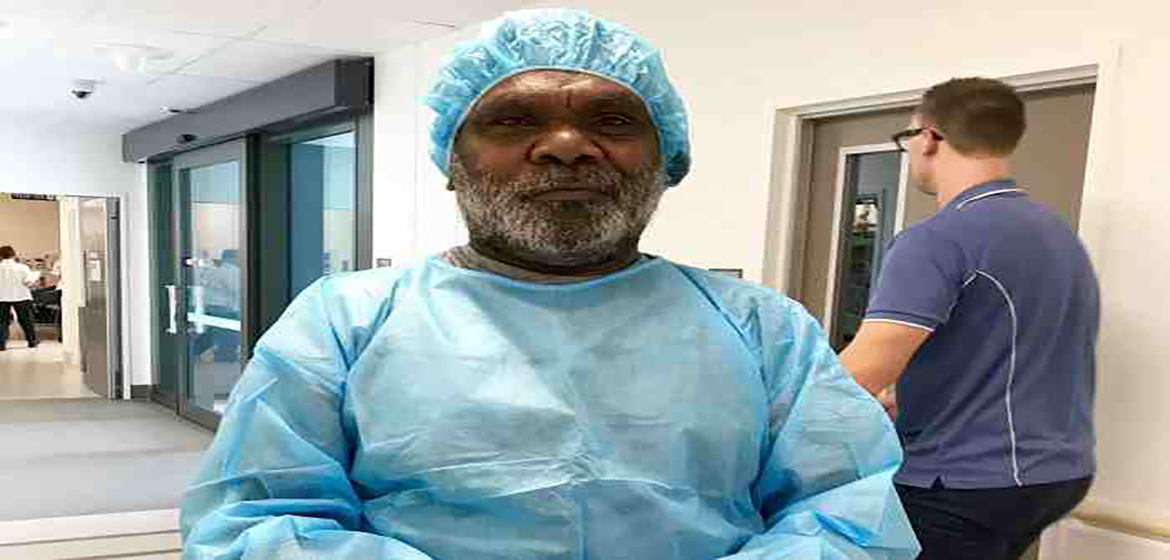By Sowaibah Hanifie
Ngangkari healers were considered the treasure of Aboriginal communities, and now their 60,000-year-old tradition has made its way to South Australia's Royal Adelaide Hospital and rural clinics.
Eighteen registered Ngangkari healers set up the Anangu Ngangkari Tiutaky Aboriginal Corporation (ANTAC) more than seven years ago.
Chief executive Francesca Panzironi heads a team visiting major hospitals and rural clinics in Victoria, New South Wales, South Australia and Western Australia.
"It all started with friendly chats, a cup of tea and kangaroo tails," she laughed.
More recently they have been working in regional clinics across country SA and the new Royal Adelaide Hospital.
"I think about 95 per cent of the Australian population doesn't know this knowledge system exists," Ms Panzironi said.
Getting recognition in mainstream health
ANTAC's objective is to provide a platform for Aboriginal healers to be recognised in the mainstream healthcare system as a form of complementary alternative medicine.
While she was a university lecturer, Ms Panzironi identified a gap in literature on Australian Aboriginal healing.
She said the most comparable form of alternative medicine to Ngangkari healing was reiki, a Japanese technique for stress reduction.
Depending on a client's problems, Ngangkari healers offer three main techniques — a smoking ceremony, bush medicines or spirit realignment.
"The healer identifies where the issues are and, through a specific method of healing, which is called panpooni, they take away whether it's pain, a blockage, or some kind of obstruction, with their hands," Ms Panzironi said.
"The most unique method of healing they use is the realignment of the human spirit.
"They see the spirit as the core component of the human body.
"If it's not in the right place it can cause problems, whether physically, emotionally, mentally. With their healing touch they push it back in the right place."
Complementary treatment for clients
Ms Panzironi said some people who used the healing technique for pain management experienced relief of their symptoms.
But for Indigenous people especially, the healers have been making a world of a difference by improving attendance rates at medical appointments.
Ms Panzironi said the treatment did not replace the role of mainstream medicine, but it could be used in conjunction with other treatments.
"I remember once the manager of the hospital said to me 'Oh my god, I have never seen so many Aboriginal people in the hospital smiling and being so happy to be here'," she said.
Riverland Community Health has been inviting the Aboriginal healers to its clinic for only a few months, and the results have been life-changing for some.
Aboriginal health consultant Kelly Matthews said before the healers' involvement, it was a struggle to get Indigenous clients to see a conventional doctor.
"It's a fear. It's how a doctor communicates. The first thing is to listen and not be judgemental," she said.
"Sitting in the sitting room they feel self-conscious. I hate it myself and my skin is pale.
"I'd rather go to the Aboriginal clinic where you sit back, can have a yarn, catch up with family and friends."
Since the healers have been involved with the clinic, appointments have been completely booked.
Respect between healer and client
Lyn Ackerman has had more than nine heart attacks, and after one occasion she contracted an infection from the surgical supplies used to unblock her arteries.
The Darumbal woman lives in Berri, miles away from her Queensland mob, and said the distance left her feeling spiritually empty.
She said the healers' power for Indigenous people lay with their ability to reconnect them to culture, the lifeblood of their spiritual being.
Ms Matthews believed traditional medicines were a pathway to improving Aboriginal health.
"They're more open. Because they are traditional they're respected. The healers also respect the clients," she said.
Making hospitals culturally acceptable
Ms Panzironi has been advocating for mainstream doctors to better understand the role Aboriginal healers can play in complementing other treatments.
It is an opinion shared by Jon Wardle, a senior lecturer in public health at the University of Technology Sydney.
He said having the Ngangkari healers in a hospital setting would educate other staff about how Aboriginal healers could make the space culturally acceptable.
"A lot of GPs don't understand traditional medicine, so automatically they have to be sceptical of something they don't understand," Dr Wardle said.
"This gives a good insight into how effective these treatments can be."
He said including healers in a hospital setting could also reduce the risks alternative medicine could have, such as physical trauma caused by under-qualified therapists, or interactions with prescriptions drugs if a patient was offered herbal medicine.
The Ngangkari healers have their own form of registration, which Dr Wardle said would reduce these potential harms.
"Really people shouldn't expect a miracle cure, they shouldn't reject other treatments," he said.
"The important thing is to have all options on the table, so if those other options are needed, they are available."
Source:
Related to SDG 3: Good health and well-being



